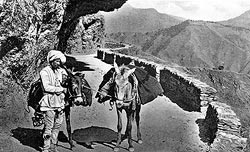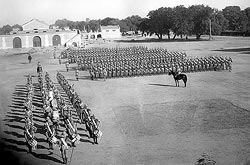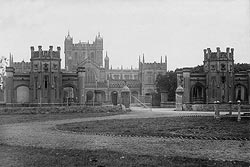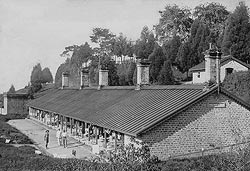Road Travel
 |
| Rocky gallery on the road to Theong, Simla.. (Click to enlarge) |
The preferred season for changing stations was that of the clear crisp days after the end of the rains and before the dust and heat returned. There was an extensive road system which had been created during the 16th century by the Mogul invaders. Best known was the Grand Trunk Road which ran from Calcutta to northern India and Kashmir. Other routes branched southwards from it at Agra. Camp sites were established along the main trooping routes, about ten miles apart, a comfortable daily distance for families and the bullock carts conveying the heavy baggage. There was time after arrival for the main meal to be prepared, for horses and pack animals to graze, or fodder to be cut for them, and for stragglers to catch up.
 |
| 1st Bn The East Surrey Regiment, Lahore, 1st January 1934. (Click to enlarge) |
Private travel by road could be a good deal quicker. There were no stage coaches as in England, although it was possible to hire a buggy and horse from Mr Cook, the livery stable keeper at Calcutta, but only for a few miles from that city. Instead the usual mode of private transport was a palanquin which was carried by a team of eight bearers, four working at a time, and escorted by torch bearers at night. Other bearers carried the luggage boxes slung on poles. They were arranged through the postal system and provided replacements appeared on time (they were replaced every two hours or so) an average of some four miles an hour could be maintained day and night. When passing through tiger country there was always keenness among the bearers to keep in front, as if the animal attacked it invariably seized the last man in the party
 |
| Queens College, Banares. (Click to enlarge) |
When the 31st moved to Meerut the sick and women and children travelled most of the way by river boat while the regiment marched. It was reported that the march took 67 days and that “the men continued very healthy, the number in hospital never exceeded thirty, many trifling cases, and but two men died..... The route of the regiment lay across the Soane, through the Shahabad district to Buscar, beneath the fort of which place it crossed the Ganges by ferry, and marched towards the military station of Ghazeepore, then occupied by the 44th Regiment. After passing this post, the regiment crossed the Goomtee by a bridge of boats; then to the cantonment of Secrole, near the city of Benares; again reached the banks of the Ganges and recrossed it to Allahabad; thence to Etawah, a city on the Jumna. From Etawah through Shekohabad and Jellasir, in the province of Agra; passing the dilapidated fort of Shasnee, the road led through the city of Coil, to the celebrated fortress of Allygher; thence by Bolundshuhur and Haupper to Meerut” where the regiment arrived on 13 January 1827. Changing stations by route march was for all ranks a great opportunity to see the country.
 |
| Single Mens Barracks, Darjeeling, 1906. (Click to enlarge) |
The regiment spent four years at Meerut and then moved to a new station which was being established at Kurnal close to the frontier with the Punjab. It arrived there early in 1831 and camped while the construction of barracks for the British regiment were being completed. Until then the cantonment had only been occupied by Indian troops who lived with their families in huts. In the new barracks each of the 31st’s companies was allocated two detached buildings. The officers were provided with bungalows which, as was the custom at the time, were built at their own expense. They paid for them and sold them on when the time came for them to move. It was the 31st’s bad luck that many years later when the regiment was posted to Ambala, a cantonment was being built there for the first time. The first few weeks had again to be spent under canvas.
Related
